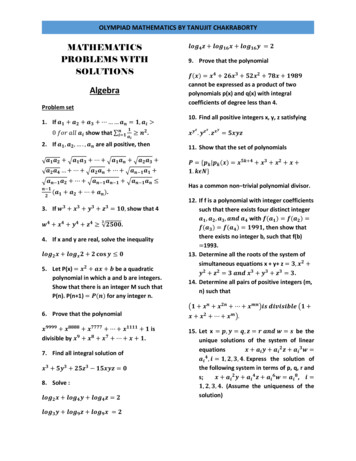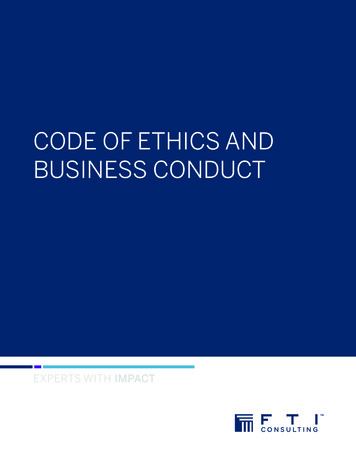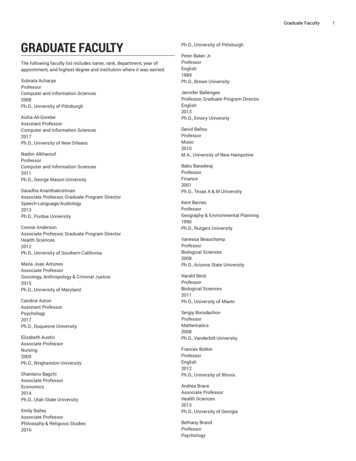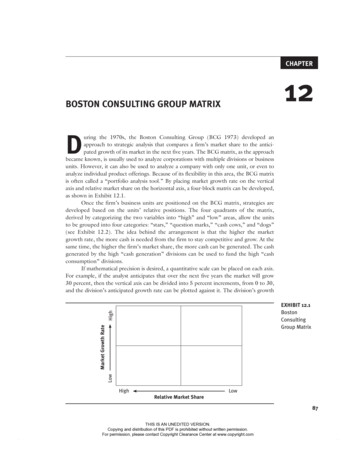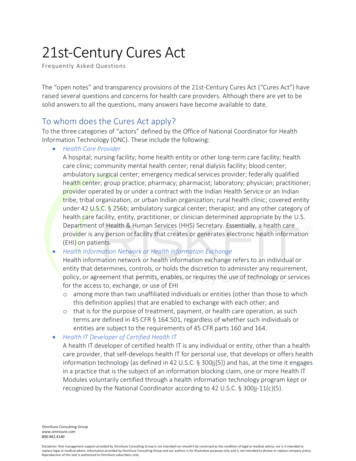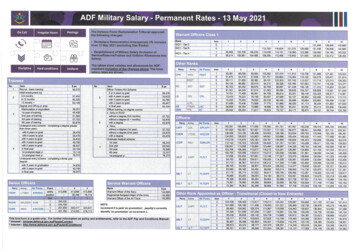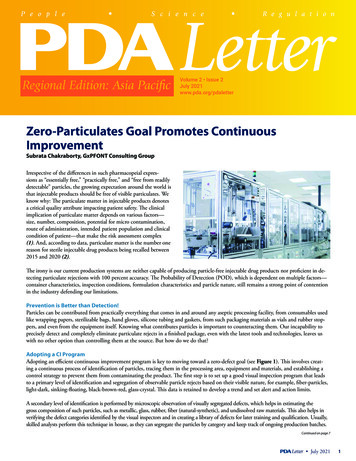
Transcription
Volume 2 Issue 2July 2021www.pda.org/pdaletterZero-Particulates Goal Promotes ContinuousImprovementSubrata Chakraborty, GxPFONT Consulting GroupIrrespective of the differences in such pharmacopeial expressions as “essentially free,” “practically free,” and “free from readilydetectable” particles, the growing expectation around the world isthat injectable products should be free of visible particulates. Weknow why: The particulate matter in injectable products denotesa critical quality attribute impacting patient safety. The clinicalimplication of particulate matter depends on various factors—size, number, composition, potential for micro contamination,route of administration, intended patient population and clinicalcondition of patient—that make the risk assessment complex(1). And, according to data, particulate matter is the number onereason for sterile injectable drug products being recalled between2015 and 2020 (2).The irony is our current production systems are neither capable of producing particle-free injectable drug products nor proficient in detecting particulate rejections with 100 percent accuracy. The Probability of Detection (POD), which is dependent on multiple factors—container characteristics, inspection conditions, formulation characteristics and particle nature, still remains a strong point of contentionin the industry defending our limitations.Prevention is Better than Detection!Particles can be contributed from practically everything that comes in and around any aseptic processing facility, from consumables usedlike wrapping papers, sterilizable bags, hand gloves, silicone tubing and gaskets, from such packaging materials as vials and rubber stoppers, and even from the equipment itself. Knowing what contributes particles is important to counteracting them. Our incapability toprecisely detect and completely eliminate particulate rejects in a finished package, even with the latest tools and technologies, leaves uswith no other option than controlling them at the source. But how do we do that?Adopting a CI ProgramAdopting an efficient continuous improvement program is key to moving toward a zero-defect goal (see Figure 1). This involves creating a continuous process of identification of particles, tracing them in the processing area, equipment and materials, and establishing acontrol strategy to prevent them from contaminating the product. The first step is to set up a good visual inspection program that leadsto a primary level of identification and segregation of observable particle rejects based on their visible nature, for example, fiber-particles,light-dark, sinking-floating, black-brown-red, glass-crystal. This data is retained to develop a trend and set alert and action limits.A secondary level of identification is performed by microscopic observation of visually segregated defects, which helps in estimating thegross composition of such particles, such as metallic, glass, rubber, fiber (natural-synthetic), and undissolved raw materials. This also helps inverifying the defect categories identified by the visual inspectors and in creating a library of defects for later training and qualification. Usually,skilled analysts perform this technique in house, as they can segregate the particles by category and keep track of ongoing production batches.Continued on page 7Letter July 20211
pda.org/2021pdafda2021 PDA/FDAJOINT REGULATORY CONFERENCESee How the Lessons from the Pandemic are Shapingthe Regulatory LandscapeJoin regulatory and industry experts for practical insights into managing today’s challenges, and sharing of experiencesfrom navigating the pandemic. A year of rapid and remarkable change has made it more critical than ever to keep up withthe latest CGMP advances and to be prepared for what the future holds.SELECT HIGHLIGHTS WILL INCLUDE: Ask the Regulators sessions, with a choice between CGMP Compliance Updates, back by popular demand! application review-based and inspection-based paneldiscussionsCompliance Updates, featuring Compliance Directorsfrom numerous U.S. FDA Centers and the Office ofRegulatory AffairsIncludes informative presentations by, and paneldiscussion with, CDER and CBER Compliance DirectorsCenter Updates, by senior officials from various U.S. FDACenters on issues that cut across the various Centersand impact the entire industryGet regulatory and industry perspectives on today’s most pressing CGMP issues, and benefit from real-life case studiestold by both industry experts and regulators!Concurrent sessions will include presentations related to Quality Assurance and QMS, Supply Chain and Manufacturing Challenges,and Emerging Trends and Innovations. The Exhibit Hall returns this year, featuring the latest in product and service solutions.Don’t miss out on this exceptional conference focusing on how the lessons of the past year will impact the regulatorylandscape of the future.Register by 31 July for the greatest registration savings!To register or learn more, please visit pda.org/2021pdafda27-29 SEPTEMBERLIVE. ONLINE. INTERACTIVE.EXHIBITION: 27-29 SEPTEMBER#PDAFDA
July 2021The PDA Letter is published 6 times per year in print, exclusively for PDA members.Articles published in the PDA Letter do not represent the official positions of PDA,Inc., but are the opinions of the authors submitting the articles.Subscriptions are not available.Articles in the PDA Letter may be reproduced with permission—contact the PDA Letter Managing Editor for details. PDA 2020PDA LETTER STAFFEXECUTIVE STAFFSenior Director of Publishing Richard JohnsonWalter MorrisPresident & CEO(301) 656-5900, ext. 148morris@pda.org Jennifer BellVP, FinanceGraphic DesignerKatja Yount Debbie Goldsteinyount@pda.org VP, MarketingPDA LETTER ASIA PACIFICEDITION EDITORIALCOMMITTEEGoal Promotes Continuous1Zero-ParticulatesImprovementVoices of PDADavid HallVP, Sales5Falk Klar, PhDVP, PDA Europe10 President’s Message: PDA Mid-Year UpdateMolly MoirVP, Programs & MeetingsMasahiro AkimotoOtsuka David TalmageVP, EducationIvy LouisVIENNI Training Glenn WrightVP, Scientific & Regulatory AffairsSubrata ChakrabortyTrevor SwanCiplaDirector, Membership & ChaptersAndiyanto SutandarHDP AsiaNews & Notes6BOD and OfficersQuality & Regulatory9ADVERTISING SALESWho Would Have Thought My Journey to Japan — Sort OfVice President, SalesDavid Hall(301) 656-5900 ext. 160hall@pda.orgPDA BOARD OF DIRECTORSOFFICERSChair Jette Christensen, PhDNovo NordiskSecretary Emma RamnarineGenentech/RocheChair-Elect Susan SchnieppRCAImm. Past Chair Rebecca Devine,PhDRegulatory ConsultantTreasurer Melissa SeymourBiogen, Inc.DIRECTORSBarbara M. Allen, PhDEli Lilly and CompanyStephan Krause, PhDAstraZeneca BiologicsMichael BlacktonAdaptimmune, LLCMary OatesEmergent BioscienceBettine Boltres, PhDWest Pharmaceutical ServicesMathias RomackerPfizer (ret.)Tia BushAmgen, Inc.Anil Sawant, PhDMerck & Co./Merck Sharp & DohmeJavier CamposanoCelltrionOsamu ShirokizawaLifeScientiaGhada HaddadMerck & Co./Merck Sharp & DohmeJoyce HansenJohnson & JohnsonArticles published in the PDA Letter do not represent the officialpositions of PDA, Inc., but are the opinions of the authors submittingthe articles.PDA GLOBAL HEADQUARTERSPDA EUROPE — AM BORSIGTURM 604350 East West Hwy., Suite 600Bethesda, MD 20814 USATel: 1 (301) 656-5900Fax: 1 (301) 986-0296info@pda.orgwww.pda.orgAm Borsigturm 6013507 Berlin, GermanyTel: 49 30 4365508-0Fax: 49 30 4365508-66info-europe@pda.orgPDA TRAINING & RESEARCHINSTITUTE4350 East West Hwy., Suite 150Bethesda, MD 20814 USATel: 1 (301) 656-5900Fax: 1 (240) 482-1659info-tri@pda.org
landAustraliaFranceItalyIsraelPDA ChaptersYour Local PDA ConnectionAre you curious about the issues unique to your region?Another layer of PDA leadership resides at the grassroots level in the Chapter organizations.Regional PDA Chapters provide local services to the membership, including translations ofPDA publications, networking social events, student scholarship and annual regulatory andtechnical conferences. Each Chapter is managed by volunteer leaders.Learn more about your local Chapter at pda.org/Chapters
Editor’s MessageWho would have thought that somehow we started the year expecting to slowly return to our new way of life inAsia, as travel bans and relatively tight quarantine rules seemed to overcome COVID-19.But the Delta variant was a game-changer, and we are pretty much back to where westarted 18 months ago.So now we begin talking about moving from pandemic to endemic. “Living with COVID,” in a non-literal way, seems to be the new topic. How to do we open up our worldagain to a freedom-of-movement model without risking the health of the general population? While the politicians and their expert advisers work this out, we in the work forcecontinue to wonder how we can prevent disruptions in our own environments.Remote inspection has made giant advances in just the past few months, but it has notyet reached a level where it can take over as the norm. Visual inspection remains a keyelement of achieving our goals. But as we move towards Pharma 4.0, these developmentswill clearly continue to evolve. Learn more about this at the “2021 PDA Remote Auditsand Inspection Workshop” on 13-14 Sept 2021. While most of you will probably beasleep at the time of the live session, you can catch up with the on-demand option thatwill be available.Marcel Ewals, PDA Asia Pacific OfficeThe Asia-Pacific manufacturing infrastructure is not equal. From outdated factories, systems, and practices to state-of-the-art plants, we seem to have it all. What we are missing,though, is a knowledgeable base of inspection experts from the region who talk to eachother and can aim to close the gaps. We need a refreshed movement to drive our qualitystandards up and ensure they remain workable and objective. In order to achieve this, weneed volunteers for our committee who will participate in writing or reviewing reportsand help create the keys the industry will need to evolve.Now is very a good time to get active, enroll the younger generation and make a difference a difference for the region! Please email AsiaPacific@pda.org for more informationand let us know how you intend to become active in PDA.Letter July 20215
PDA NewsPDA’s Volunteer Board of Directors Includes 2 Membersfrom Asia-PacificThe 2021-2022 PDA Board of Directors is one of the most diverse ever. Besides the first all-female Executive Committee and the firstChair working in Europe, it includes two Directors who work in Asia-Pacific.South KoreaJapanJavier CamposanoCelltrion Inc.Osamu ShirokizawaLifescientia2021 BOD and OfficersChairJette Christensen, PhDNovo NordiskBarbara M. Allen, PhDEli LillyJoyce HansenJohnson & Johnson6Letter July 2021Chair-ElectSue SchnieppRCAMichael BlacktonAdaptimmuneStephan Krause, PhDAstraZeneca BiologicsTreasurerMelissa SeymourBiogenBettine Boltres, PhDTia BushWest Pharmaceutical Services AmgenMary Oates, PhDPfizerMathias RomackerPfizer (ret.)SecretaryEmma RamnarineGenentech/RocheJavier CamposanoCelltrionAnil Sawant, PhDMerck & Co., IncImmediate Past ChairRebecca Devine, PhDRegulatory ConsultantGhada HaddadMerck & Co.Osamu ShirokizawaLifeScientia
Quality & RegulatoryZero-Particulates Goal Promotes Continuous Improvement continued from page 1A thorough understanding of the failuremode that results in particle generationand contamination in injectable productsis like winning the half-battle towardthe zero-particulate goal. Setting up acontinuous improvement program andcontrolling variability by the qualificationand standardization of all materials, components and equipment parts can help getone step closer to this challenging goal.Constant collaboration and open communication among sterile-product manufacturers, suppliers, and regulatory agencies isan essential element in this endeavor.It is not a question of whether Zero Particles is a realistic goal, but it is desirablefor patient safety and drives continuousprocess improvement!Figure 1 Continuous Improvement Cycle for Visible Particulate-Free Injectable ProductsNext, further in-depth analysis of theserepresentative particle samples can beconducted using spectroscopic or otherfingerprinting techniques using such technologies as FTIR, Raman or SEM/EDS.This ultimate level of identification provides meaningful information about thenature of the particles. The findings fromthis level of identification are helpful forscouting the source of the particles in theproduction area and incoming materials.Having identified the nature of the particles, the next step is to identify the source.This requires scanning through everythingthat comes into the vicinity of the asepticprocessing area, adeptly collecting particlesamples and running a similar characterization test.The entire program can best be managedby a shop-floor cross-functional teamusing a predefined protocol that governsthe complete process of sampling, testing,investigation, corrective and preventativeactions and follow-up. A well-defined frequency of conducting such an exercise helpsmaintain continued control over potentialparticulate sources and improves on theprocess. Special attention should be paid ifany atypical particles or unusual rejectiontrends are observed during inspection or thesubsequent identification process.Implementing Qualification CriteriaImplementing good testing and qualification criteria, with respect to the particleshredding characteristic of each material,component and equipment part enteringinto the aseptic processing area, is thekey to good particulate control in theproducts. This entails constant collaboration and benchmarking with the suppliers to build and maintain the quality ofall input materials by setting mutuallyagreeable specifications. Choosing theright fit-for-purpose materials or components and assigning a usage life to each ofthem is an important part of this controlstrategy. A change in any of the materials,components, equipment or parts—however trivial it might look—must meetthose qualification criteria to avoid laterconsequences.References1. U.S. Pharmacopeial Convention. USP 1790 Visual Inspection of Injections. In USP43–NF38, p. 8587.2. Shabushnig, J G. The Changing VisualInspection Regulatory Environment.Presented at 2021 PDA Visual Inspection Forum, 14-15 April, 2021.Other ReadingLangille, S E. Visible Particulate Contamination Control for Injectable Products: ALife-Cycle Approach. PDA J Pharma SciTech May 2020, 74(3), 359-366.Johns, J., et al. Achieving Zero Defectsfor Visible Particles in Injectables. PDA JPharma Sci Tech November 2018, 72(6),640-650.About the AuthorSubrata Chakraborty leadsthe GxPFONT ConsultingGroup as PrincipalAdvisor and has over 24years of experience inhandling pharmaceuticalmanufacturing and qualityoperations in various capacities withexpertise in aseptic technology. He alsovolunteers for the PDA Letter EditorialCommittee for the Asia-Pacific region.Letter July 20217
pda.org/2021remoteaudits2021 PDARemote Auditsand InspectionsWorkshopREGISTER BY31 AUGUSTTO SAVE!Is Your Company Ready for a RemoteAudit or Inspection?Join PDA on 8-9 September for a two-day interactive Workshop to gain the tools and practical solutions youneed to successfully overcome challenges in preparing for and hosting remote audits and inspections.Through presentations, case studies, and video role play drawing on industry experiences, this Workshop willexplore important topics, including: The benefits and challenges of hosting and conducting remote audits and inspectionsApplying a risk-assessment approach during audits and inspectionsAnticipating perils and pitfalls: The impact of culture on communication during remote auditsFirst-hand experiences of auditors and regulators in conducting virtual audits of remote internaloperations and suppliersFind out what your company needs to do before and during your remote audit or inspection to ensure success!For more information and to register, visit pda.org/2021remoteaudits13-14 SEPTEMBER 2021LIVE. INTERACTIVE. ONLINE#2021remoteaudits
Quality & RegulatoryMy Journey to Japan — Sort OfMarilyn L. Foster, PDAAlmost four years in the making, thefinal guidance document from the PDAJapan Chapter is well worth the wait.Environmental Control and Maintenancein the Manufacturing of Non-Sterile DrugProducts: Kansai Study Group (KSG) ofthe PDA Japan Chapter was added to thePDA Bookstore on 24 June, the culmination of a journey that began in July 2017.My first introduction to the topic camefrom former PDA VP for Scientific andRegulatory Affairs and current PDA JPSTEditor Richard Levy, PhD, when heasked me to work with Keisuke Inoue,Takeda, and Osamu Shirokizawa, Lifescientia, to prepare an article for the Journalreviewing the 90-page document and itsbackground. A series of back-and-forthemails ensued, as I stumbled through thelinguistics involved in understanding thedifferent meanings of technical terms andconcepts in the Japanese English versionof the article. One instance really caughtme up short when I saw the diagram forthe entrance and exit paths of the dressingand undressing rooms.In the process, I learned that in many Japanese pharma manufacturing facilities, thetechnicians are provided with uniformsto wear, rather than coverings over theirstreet clothes; hence, the separate dressing/undressing rooms for men and women. Idiscovered more about the developmentof the guidance document that formedthe basis for the Journal article when Iviewed the poster Inoue and Shirokizawapresented at the “12th Annual PDA GlobalConference on Pharmaceutical Microbiology” in October 2017. Their exhibitionwas very enlightening and meeting thegentlemen from Japan in person was a realtreat. Finally, the faces behind the emails!The opportunity proved valuable to Inoueand Shirokizawa as well; in addition toattending the conference, they toured thethen-new TRI training center. Shirokizawa wrote: “We received a lot of visitors toour poster throughout the sessions. Wehad insightful discussion with them.***[AtTRI] We saw PDA has been providing avariety of training to learn about manykey features of aseptic processing. Weknow how effective and important handson training is to any trainee.”The sojourn through the manuscriptsubmission process, needless to say, wasa lengthy one. We tapped into the PDAmembership to find reviewers knowledgeable about the subject. The first round ofreviewers commented that it was difficultto make a decision about a paper based ona document they couldn’t see. While thefull guidance document had been translated to English, the initial version neededadditional editing to convert some of theterms to their American English equivalents. And I became a translator.Over the years of sending sections ofmy “translations” for the JPDA teamto accept, reject or amend, we began arespectful business friendship: Shirokizawaand Inoue became the more informalOsamu-san and Keisuke-san. We learneda little about one another’s lives, culturesand perspectives. Osamu volunteered towork on the TR 29 revision team and experienced the global collaborative effort ofdeveloping technical reports. He was latervoted to join the PDA Board of Directors.Osamu served as the primary contactbetween the PDA Publishing Group andthe KSG, who provided feedback on allof the translated sections. I was humbledby the experience of knowing so manytop business leaders took the time to readmy many, sometimes minute, commentsand changes in their valuable document.They truly valued the opportunity to shareall they had learned through the originalsurvey they conducted of pharmaceuticalmanufacturers in Japan and the best practices they had developed as a result.In October 2019, Osamu stopped over ona business trip to meet again with WalterMorris, PDA Sr. Director, Publishing &Press Relations, and me at PDA’s Bethesdaoffice. We spent some time going overthe plans and timelines for converting thechapters of the guidance document andchecking on the progress of the Journalarticle. It was a great opportunity to jugglewhat we said and how they understood itand vice versa. (This was when I learnedabout the dressing rooms.)The time between now and then comprised numerous rounds of editing, commenting, revising, proofreading, and correcting on both sides of the world and thestrings of emails that bridged the globe. Aglobal pandemic interrupted the processand slowed down everything it didn’t stopimmediately. And, at last, this productionled to the final typesetting and publishingof, in my humble and completely unbiased opinion, both masterpieces.To make a long story short, the final JPDAarticle, “Overview of ‘The Study in Riskbased Manufacturing EnvironmentalControl for Non-sterile Drug Products’ byOsamu Shirokizawa, Keisuke Inoue andTsutomu Kamikukita, was published as anAccepted Article on the PDA JPST websiteon 14 May 2021. And the English translation of the Environmental Control and Maintenance in the Manufacturing of Non-SterileDrug Products: Kansai Study Group (KSG) ofthe PDA Japan Chapter was made available inthe PDA Bookstore on 24 Jun 2021.I hope sometime to visit our associates inJapan to see what else I can learn of theirculture. In the meantime, pick up a copyof their guidance for yourself or yourcompany. I am sure you will find somevaluable and practical advice!Letter July 20219
President’s MessagePDA Mid-Year UpdateRichard Johnson, PDASince early 2020, the entire world has been in the grips of a global pandemic. As of 4June 2021, over 170 million cases of COVID-19 have been reported, with more than 3.7million deaths. Each of us, directly or indirectly, has been impacted by this pandemic orits effects.On a positive note, more than two billion doses of vaccine have been administered worldwide, largely through the efforts of our community, which has developed, manufacturedand distributed vaccines with unprecedented speed. In some parts of the world, we areseeing a gradual return to “normalcy,” but unfortunately, in other parts of the world, thepandemic is still raging, and vaccine administration has not yet reached desirable levels.We understand some volunteers may be concerned how PDA is weathering the pandemic.Richard Johnson, PDA PresidentSince March of last year, our staff has been working mostly from home. We have had toshift many of our activities from in-person to virtual formats. This has been challengingand has affected our finances.PDA is financially very sound, and through diligent management, PDA still has morethan 12 months of reserves, despite the decrease in revenue through 2021.We have had to react to the changing situations and, although we had hoped to beginface-to-face meetings in Q-2/3, for most of 2021, our conferences will be virtual.Training, Membership and Publications revenue is starting to recover.We have not laid off any employees due to the pandemic, but we have not filled somevacancies. We are gradually starting to fill some of these positions.Our Board of Directors, Advisory Boards, Committees and Task Forces are all meetingvirtually. Thank you to all the volunteers who continue to contribute!These are challenging times for the whole world, including PDA. This year, PDA iscelebrating its 75th anniversary. With your continued support and participation, PDA willcontinue to Connect People, Science and Regulation for many years to come.10Letter July 2021
Ivy Louis . aining r T. Subrata Chakraborty. Cipa. Andiyanto Sutandar. P sia ADVERTISING SALES Vice President, Sales. David Hall 1 - ext. 1 hallpda.org. The P etter is puished times per ear in print eusive or P memers. Arties puished in the P etter do not represent the oia positions o P n ut are the opinions o the authors sumitting the arties
